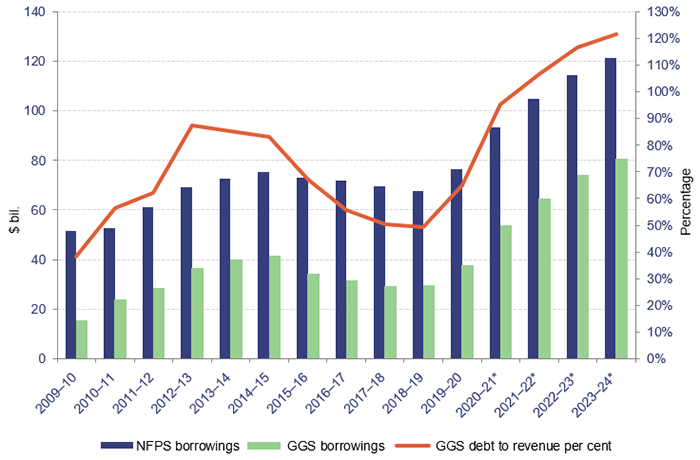Overview
Each year, the Treasurer prepares consolidated state government financial statements. These statements separately disclose transactions and balances for the total state sector, including the general government sector.
Tabled 18 March 2021.

Auditor-General’s foreword
In 2019–20 the Queensland Government was faced with the extraordinary task of responding to the COVID-19 pandemic. In addition to the health response, government entities needed to act rapidly by implementing measures to support individuals, businesses, and the Queensland economy. I recognise the significant efforts many entities took and their achievements over the past year.
The impact of the extraordinary year was felt by the state’s finances—the state recorded its first deficit in seven years and had to borrow $4.5 billion more than originally budgeted. The increased spending supported the rapid responses to the pandemic.
My report to parliament—Queensland Government response to COVID-19
(Report 3: 2020–21)—gave an overview of measures in response to the COVID-19 pandemic announced by the Queensland Government up to 21 August 2020.
While the government’s ongoing response to the pandemic will continue to place pressure on Queensland’s financial performance and position in the coming years, it is also aimed at supporting economic recovery over the longer term. The government will rely more on borrowings over the next four years with these forecast to reach $121 billion by 2023–24.
This will require the government to manage its expenditure and ensure debt levels are sustainable. Given these ongoing pressures and uncertainties it is important the government monitors, assesses and reports on:
- the effectiveness of measures implemented in response to the pandemic
- actions taken in implementing its savings and debt plan, targeting savings of $3 billion over the next four years, and the extent to which these savings are being achieved
- how state debt is being managed including through the establishment of the Queensland Future Fund—Debt Retirement Fund.
I will continue to monitor the actions the government takes per the above challenges—and the outcomes they achieve—and report on them to parliament.
The years ahead will be challenging.
Brendan Worrall
Auditor-General

Report on a page
The Queensland Government’s financial statements are reliable but not always timely
The financial statements for the Queensland Government, the consolidated fund, the report on ministerial expenses, and the report on the office expenses of the leader of the opposition are all reliable and comply with legislative requirements.
This year, the Queensland Government financial statements were signed earlier than the prior year, but after the state election. We recommend the government establishes a statutory deadline to ensure timely public reporting of these results.
The state’s financial performance was significantly impacted by COVID-19
COVID-19 and the resulting domestic and global economic downturn substantially affected the state’s main revenue streams in 2019–20, including from goods and services tax (GST) grants, taxation, the provision of government services, and royalties (mainly from the extraction of coal).
The substantial downturn in economic activity from COVID-19 significantly reduced total GST collections by the Australian Government, which reduced the amount of GST it paid to the states and territories as GST grants. The Queensland Government received $1.6 billion (11 per cent) less GST funding this year. This decline is expected to continue in 2020–21 as the ongoing impacts of COVID-19 continue.
The Queensland Government’s expenses increased significantly because it introduced economic relief packages in response to COVID-19. In addition, the growing public sector workforce, particularly in health and education, also contributed to the increasing expenses.
The Queensland Budget 2020–21 recognises there will be difficulties in increasing revenue over the next four years. The budget also forecasts that expenses will increase over the same period as the government continues to respond to COVID-19 and implement plans for economic recovery. The government is aiming to limit the expenses of the general government sector (government departments and other non-trading entities) through a savings and debt plan, targeting savings of $3 billion over four years to 2023–24.
Debt levels are expected to significantly increase
Additional borrowings were required this year to partially fund the government’s response to COVID-19. Borrowings are expected to significantly increase over the next four years as the government continues to respond to COVID-19 with its economic recovery plan, including an increased capital works program. Some of the additional borrowings will be required to fund the government’s operating expenses in 2020–21, for the first time in eight years.
In response to the increased debt, the government will establish the Queensland Future Fund—Debt Retirement Fund by 30 June 2021. The government has estimated the fund will hold $5.7 billion in state investments that can be used only for reducing state debt. To enhance transparency, we recommend that for each fund established as part of the Queensland Future Fund, the government prepares financial statements, which are audited, and made publicly available.

Recommendations
Introduce a statutory time frame for the consolidated whole-of-government financial statements (Treasurer and Queensland Treasury) |
|
|
We recommend that the Financial Accountability Act 2009 be amended to include a statutory time frame for the certification and tabling in parliament of the consolidated Queensland Government financial statements each year. We also recommend that in an election year, the financial statements are certified prior to 31 October to allow for tabling prior to the state election. |
|
Introduce a statutory requirement for annual financial statements to be prepared for funds established under the Queensland Future Fund Act 2020 (Treasurer and Queensland Treasury) |
|
|
We recommend that the Queensland Future Fund Act 2020 (QFF Act) be amended to include a requirement for financial statements to be prepared, audited, and made publicly available for each fund created under the QFF Act. These requirements could be based on those included in section 7 of the NSW Generations Funds Act 2018. These financial statements should include information on the underlying investments that support each fund. |
|

1. Overview of entities in the Queensland Government
This report analyses the consolidated financial position of the Queensland Government, referred to as the total state sector (which includes the sectors and corporations shown in Figure 1A). We provide separate reports to analyse the results of our audits for specific industry sectors, including health, energy, water, and transport.
This report also refers to the non-financial public sector, which is a combination of the general government and public non-financial corporation sectors.
Queensland Audit Office.

2. Results of our audits
This chapter provides an overview of our audit opinions on the:
- Queensland General Government and Whole of Government Consolidated Financial Statements
- Consolidated Fund Financial Report
- the Public Report of Ministerial Expenses and the Public Report of Office Expenses for the Office of the Leader of the Opposition.
Chapter snapshot
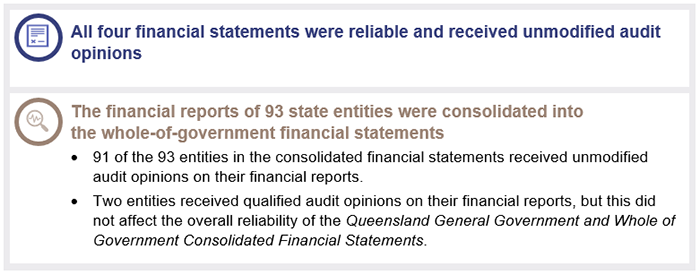
We express an unmodified opinion when the financial statements are prepared in accordance with the relevant legislative requirements and Australian accounting standards.
We issue a qualified opinion when the financial statements as a whole comply with relevant accounting standards and legislative requirements, with the exception noted in the opinion.
Queensland Government financial statements
The Financial Accountability Act 2009 requires the Treasurer to prepare annual consolidated financial statements for the Queensland Government. On 25 November 2020, we issued an unmodified audit opinion on the Queensland Government’s 2019–20 consolidated financial statements, which means we consider the financial statements can be relied upon.
Consolidation of financial reports of significant state entities
The consolidated financial statements for the Queensland Government reflect the combined financial results for 93 individual state entities. These entities are the most significant to the financial performance and position of the Queensland Government.
We issued unmodified opinions on the financial statements for 91 of these entities.
We issued a qualified opinion on Seqwater’s financial statements for not recording a liability and matching expense as a result of the unfavourable court judgement relating to the 2011 South East Queensland floods class action. This did not affect our opinion on the consolidated Queensland Government financial statements, as they included an estimate for the total liability for the Queensland Government arising from the class action (including Seqwater’s share). Our report Water 2020 (Report 9: 2020–21) provides further details on this.
The Queensland Rural and Industry Development Authority (QRIDA) provided almost $1 billion in loans under the COVID-19 Jobs Support Loan Scheme to businesses in need. Given the uncertain economic conditions, it was difficult to estimate the ability of these businesses to repay the loans. QRIDA provided analysis and an estimate of the loans that would be repaid in the future. We determined this estimate could not be relied on and qualified our audit opinion on QRIDA’s 2019–20 financial statements. This issue did not have a major effect on the consolidated Queensland Government financial statements. It is examined in our report State entities 2020 (Report 13: 2020–21).
Timely certification of the consolidated financial statements
The Financial Accountability Act 2009 (FA Act) does not currently provide a statutory deadline for the finalisation of the consolidated Queensland Government financial statements—the only requirement is that the financial statements must be prepared within six months after the end of each financial year. The finalisation of the financial statements by the Treasurer over the last 10 years has occurred between 16 October and 24 January—a range of over three months. Information in the financial statements becomes less relevant to readers the further away it is from the end of the financial year. In 2020, it also meant information on the Queensland Government’s financial performance and position was not publicly available prior to the state election.
By comparison, legislation in Victoria and New South Wales requires their consolidated state government financial statements to be finalised by 15 October and 22 October respectively. Figure 2A compares the number of days taken to finalise the consolidated state government financial statements in Queensland, New South Wales, and Victoria over the last 10 years.
Note: New South Wales amended the legislative due date for the Report on the State Finances 2019-2020 to 17 November 2020 in the COVID-19 Legislation Amendment (Emergency Measures—Treasurer) Act 2020. NSW—New South Wales; VIC—Victoria; QLD—Queensland.
Queensland Audit Office.
In the current economic climate, it is even more important to have reliable, relevant, and timely financial statements. In my report on State entities 2020 (Report 13: 2020–21), I have raised a similar issue regarding delays between financial statements being finalised and being made publicly available.
Recommendation for the Treasurer and Queensland TreasuryIntroduce a statutory time frame for the consolidated whole-of-government financial statements (REC 1) |
|
We recommend that the Financial Accountability Act 2009 be amended to include a statutory time frame for the certification and tabling in parliament of the consolidated Queensland Government financial statements each year. We also recommend that in an election year, the financial statements are certified prior to 31 October to allow for tabling prior to the state election. |
The financial report on the consolidated fund
The consolidated fund is the Queensland Government’s central bank account. Revenue and other money received by the government, including taxes, royalties, Australian Government grants, fines, and vehicle registration fees are paid into the consolidated fund. Dividends paid by government owned corporations (to the government, as their owners) are also paid into the consolidated fund.
Each year, government departments receive funding from the consolidated fund, referred to as ‘appropriations’. The amounts appropriated to departments are approved by parliament as part of the annual state budget process. In 2019–20, additional funding amounting to over $3.6 billion was provided to departments for the delivery of specific COVID-19 relief measures.
The FA Act requires the Treasurer to keep a ledger recording the amounts received into and paid out of the consolidated fund. The Consolidated Fund Financial Report acquits these amounts each year. It also compares amounts provided to departments against the amounts approved by parliament.
Result of our audit
We issued an unmodified audit opinion on the Consolidated Fund Financial Report on 28 August 2020, before the legislative deadline of 30 September 2020. We included an emphasis of matter paragraph to draw attention to the fact that the report was prepared on a cash basis. The inclusion of an emphasis of matter does not modify the audit opinion.
Public reports of ministerial expenses
Ministers and assistant ministers have staff and resources to assist them in their duties. The Department of the Premier and Cabinet administers expenditure for ministerial offices and for the Office of the Leader of the Opposition. In 2019–20, total expenses incurred were $46.8 million, a decrease of $1.03 million (2.2 per cent) on the previous year.
The FA Act requires the Department of the Premier and Cabinet to prepare an annual public report of ministerial expenses. The Opposition Handbook also requires the Leader of the Opposition to prepare, and have audited, an annual report of expenses.
Results of our audits
We issued unmodified audit opinions on the Public Report of Ministerial Expenses and the Public Report of Office Expenses for the Office of the Leader of the Opposition on 26 August 2020 and 12 August 2020 respectively. We included an emphasis of matter paragraph to draw attention to the fact that these reports are prepared for specific purposes—to fulfil responsibilities under the FA Act and the Opposition Handbook.

3. Financial performance of the Queensland Government
This chapter analyses the financial performance, position, and sustainability of the Queensland Government. We assess the main transactions and economic events for the year as well as relevant emerging issues.
Chapter snapshot
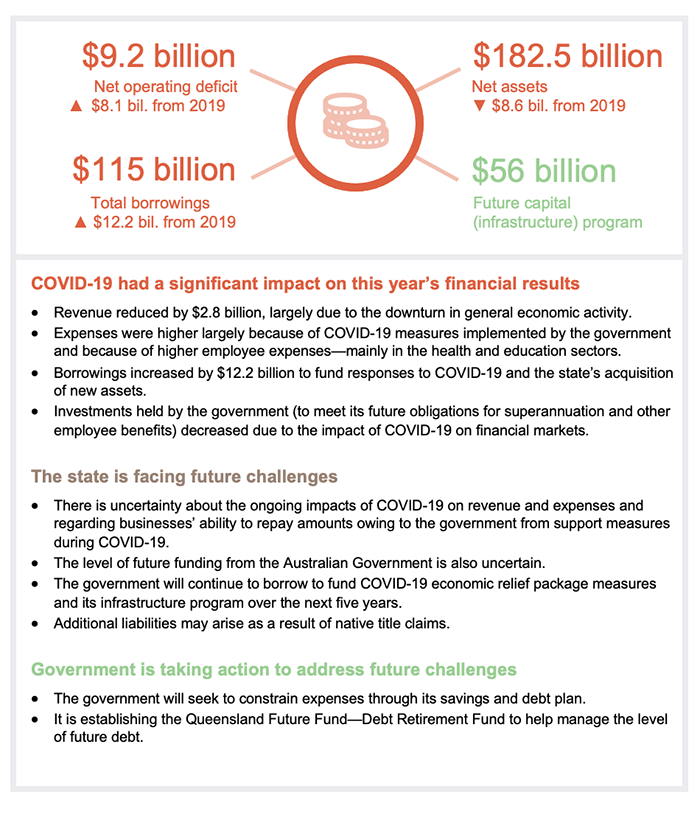
The financial performance of the Queensland Government declined significantly this year
The ‘net operating balance’ is a key measure of financial performance. It shows the revenue earned by the Queensland Government against the expenses it incurred on day-to-day operations. When there are more expenses than revenue, the net operating balance is in deficit.
This year, the Queensland Government reported a net operating deficit of $9.2 billion for the total state sector (TSS—all government-related entities and corporations, including the general government sector), an increase of $8.1 billion on the prior year.
The net operating balance for the general government sector (GGS—government departments and other non-trading entities) was a deficit of $5.7 billion, compared with a surplus of $985 million in 2018–19. This was the first deficit in seven years.
In our report Queensland Government state finances: 2018–19 results of financial audits (Report 11: 2019–20), we noted that the financial performance of the Queensland Government had reduced over the previous two financial years, with expenses incurred increasing at a greater rate than revenue earned.
This trend continued this year. The downturn in economic activity due to COVID-19 led to lower revenue. At the same time, expenses significantly increased as the state attempted to mitigate the effects of the pandemic. Figure 3A shows total revenue and expenses over the last five years.
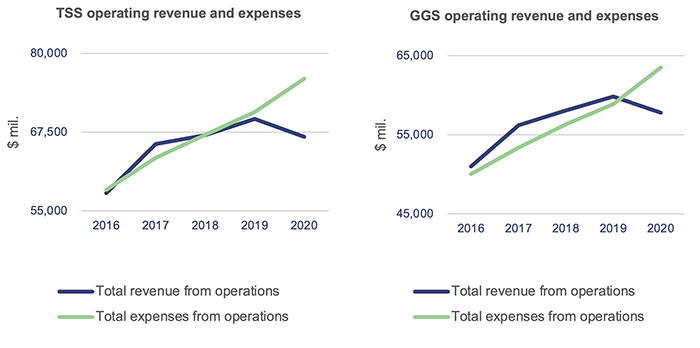
Queensland Audit Office.
Risks to Queensland’s future financial performance
The extent to which the Queensland Government’s future financial performance improves will depend on several factors, including COVID-19.
The Queensland Budget 2020–21 identifies the global evolution of the pandemic as a major risk to future performance. Further outbreaks could require the Queensland Government to introduce new stimulus measures not currently budgeted for or expand on those included in the budget.
In addition, risks arising from ongoing international geopolitical and trade tensions may impact on the state’s revenue and key exports. The Queensland Budget 2020–21 has forecast that coal prices are expected to weaken further in early 2021.
Total revenue decreased by $2.8 billion and is expected to be $12.3 billion lower than forecast prior to COVID-19
Revenue earned by the state in 2019–20 decreased by four per cent to $66.8 billion, with COVID-19 having a big impact on several major revenue sources. Figure 3B shows the movement in major revenue sources for the total state sector this year.
Queensland Audit Office.
While the Queensland Budget 2020–21 forecasts revenue to increase over the next four years, it will be $12.3 billion lower than the revenue that was forecast in the 2019–20 Mid-Year Fiscal and Economic Review (MYFER), which was produced prior to COVID-19.
Figure 3C shows the historical and forecast amounts for the general government sector revenue sources that are significantly affected.
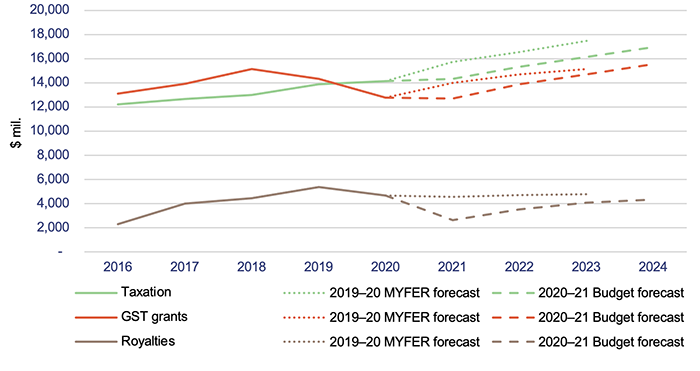
Note: GST—goods and services tax; MYFER—Mid-Year Fiscal and Economic Review.
Queensland Audit Office.
Queensland’s share of revenue from goods and services tax is decreasing
This year, goods and services tax (GST) funding (paid to the state by the Australian Government as a grant) reduced by approximately $1.6 billion (11 per cent) due to:
- the Australian Government collecting lower GST revenue. This reflected the impact of COVID-19 on general economic activity in Australia
- Queensland’s share of the GST pool decreasing from 22 per cent to 21.1 per cent, as determined by the Commonwealth Grants Commission.
The decrease in GST revenue was partially offset by other grant revenue received from the Australian Government, including:
- funding provided under the COVID-19 Health National Partnership Agreement
($345 million) - other grant funding from the Australian Government brought forward from 2020–21 to provide additional economic stimulus, including financial assistance grants paid to local governments ($721 million) and funding for non-state schools ($386 million).
The Australian Government provides funding to states and territories through national non‑infrastructure partnership agreements to support the delivery of specific projects or delivery of agreed government services, for example, for essential vaccines and COVID‑19 domestic and family violence responses.
The Queensland Budget 2020–21 identified that there are 11 non-infrastructure national partnership agreements due to expire on 30 June 2021 for which the Australian Government has not allocated any funding beyond 2020–21. A non-renewal of these funding agreements could impact on the Queensland Government’s capacity to meet ongoing community service needs.
Royalties decreased due to COVID-19
The Queensland Government earns royalties from the extraction of coal, metals, petroleum and gas, and other minerals. Royalties decreased by $720 million (14 per cent) in 2019–20, largely because of decreases in the volume and price of coal exports, with COVID-19 driving weaker global demand for coal.
Some taxation revenue may not be collected
Taxation revenue increased by $276 million (two per cent) in 2019–20. However, taxation revenue recognised in the 2019–20 consolidated financial statements was $579 million lower than was estimated in the 2019–20 budget.
This reflects the broader economic impact of COVID-19. Employment and wages were lower than expected, and relief measures were implemented by the Queensland Government, including a payroll tax exemption on the Australian Government’s JobKeeper payments.
The state government also provided a payroll tax payment ‘holiday’ for eligible businesses, resulting in taxation owing to the state being deferred to future years. Given the impact of COVID-19 on the current economic climate, there is an increased risk the state may not collect the full amount of taxation owed to it.
Other state revenue decreased
Revenue from the sale of goods and services provided by the Queensland Government decreased by $1.03 billion (six per cent) in 2019–20.
This was largely because lower electricity prices resulted in decreased revenue collected by electricity generators. Revenue from public transport fares and hospital fees was also lower.
Interest revenue also decreased by $743 million (44 per cent) in 2019–20. This reflected lower returns on investments due to a downturn in financial markets arising from the impacts of COVID-19.
Total expenses increased by over $5.2 billion
Expenses incurred by the state in 2019–20 increased by seven per cent to $76 billion due to:
- an increase in grants expenses of $1.9 billion (22 per cent), including tax rebates paid under COVID-19 relief measures (including payroll tax refunds of $393 million and land tax rebates of $81 million) and financial assistance grants paid to local governments
- an increase in employee expenses of $1.8 billion, driven by increases in employee numbers in health and education
- an increase in other operating expenses of $1.1 billion (five per cent), including electricity rebates to households of $490 million under COVID-19 relief measures, and increased claims under insurance and other compensation schemes
- recognition of estimated litigation and settlement costs of $1.08 billion for a class action that arose from the 2011 Queensland floods.
Our report to parliament—Queensland Government response to COVID‑19 (Report 3: 2020–21)—gave an overview of measures in response to the COVID‑19 pandemic announced by the Queensland Government up to 21 August 2020.
Constraining future government expenditure
The government’s policy response to COVID-19, as well as the need to fund election commitments to support economic recovery over the longer term, is expected to increase general government sector expenses from 2019–20 to 2023–24. In 2020–21, these expenses are budgeted to increase by $1.4 billion to $64.9 billion, and they are expected to grow at an average annual rate of 1.6 per cent over the four years to 2023–24.
Given the increased expenses in meeting these commitments, the government is implementing a savings and debt plan to target savings of $3 billion over the four years to 2023–24. This plan will focus on expenditure in government advertising, accommodation, information technology, workforce requirements, structural reform opportunities, and reviews of agency functions.
Liabilities are increasing and financial asset returns are at risk
The Queensland Government’s response to COVID-19 has significantly and adversely affected the state’s balance sheet in 2019–20 and will continue to do so for several years. In addition to significantly increasing the level of forecast state debt, the current economic climate will also make it challenging to manage the state’s financial assets, such as cash, investments, and receivables (the amounts it is owed).
The 2020–21 budget identified that some of the government’s fiscal principles will not be achieved in the short to medium term (for example the principle targeting ongoing reductions in Queensland’s relative debt burden). The government will develop a new charter of fiscal responsibility, which will include renewed long-term fiscal principles to better reflect the current economic conditions and government priorities. Queensland Treasury will report on these renewed principles in the 2021–22 budget.
This year, the state’s net worth (the difference between total assets and total liabilities) declined by $8.6 billion (4.5 per cent). This reflects an increase in the state’s liabilities of $22.8 billion, which exceeds the increase in its financial assets and physical assets (for example, roads). Figure 3D shows the net worth for the total state sector for the past seven years.
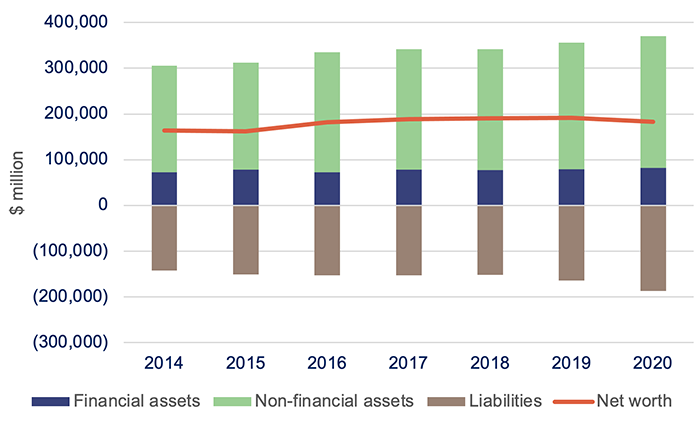
Queensland Audit Office.
The decline in net worth was largely driven by:
- additional borrowings of $12.2 billion to fund COVID-19 economic relief package measures and the state’s infrastructure program. The value of the assets constructed with these borrowings partially offsets the liability
- an increase of $2.8 billion in provisions reflecting the government’s obligation under several insurance and compensation schemes and estimated liabilities arising from litigation against the state, including the 2011 South East Queensland floods class action
- an increase of $1.3 billion in the Queensland Government’s superannuation and employee entitlement obligations, and a decrease of $3.1 billion in the value of the investments held to fund these obligations.
On 26 February 2021, the Premier and Minister for Trade announced that an agreement had been reached to settle the claims against the state and SunWater arising out of the floods class action. The settlement is subject to approval by the court and agreement to the terms of the settlement deed. If approved, SunWater and the state would pay $440 million to settle the claims against them, including for costs and interest.
Additional borrowings to fund the response to COVID-19
In 2019–20, the value of total state sector (TSS) borrowings increased by $12.2 billion (11.9 per cent) to $115 billion. TSS borrowings represents all amounts borrowed by Queensland Treasury Corporation (QTC) on behalf of the state and includes amounts on-lent to non-Queensland Government entities (for example, local governments and universities) and amounts borrowed in advance of current requirements and invested by QTC.
Non-financial public sector (NFPS) borrowings are a subset of TSS borrowings. They represent amounts borrowed by QTC and on-lent to the general government sector (for example Queensland Treasury) and public non-financial corporation entities (for example government owned corporations and large statutory bodies). At 30 June 2020, NFPS borrowings were $76.5 billion—an increase of $8.9 billion in 2019–20.
The value of GGS borrowings, which form part of the NFPS borrowings, was $37.6 billion at 30 June 2020—an increase of $8.1 billion on 30 June 2019.
While the Queensland Budget 2019–20 identified additional borrowings for non-financial public sector entities to fund planned capital projects (for example, transport infrastructure including Cross River Rail), borrowings at 30 June 2020 were $4.5 billion more than the budgeted amount. The additional borrowings were largely used to support COVID-19 measures not planned for in the budget.
The Queensland Government’s borrowings will continue to increase
The Queensland Budget 2020–21 forecasts that borrowings for the general government sector and non-financial public sector entities will increase over the next four years. The increased borrowings will be predominately used to fund the state’s investment of $56 billion in capital projects. This includes $12.6 billion for the purchase or construction of physical assets, like infrastructure, in 2020–21—an increase of 14.6 per cent on 2019–20.
To ensure debt levels are sustainable, the Queensland Government has a fiscal principle targeting ongoing reductions in Queensland’s relative debt burden, as measured by the general government sector’s debt-to-revenue ratio. The Queensland Government has acknowledged in the Queensland Budget 2020–21 that its targeted debt-to-revenue ratio will not be achieved in the short to medium term. Instead, it is prioritising support for economic recovery over existing fiscal targets.
Figure 3E shows the increase in borrowings and the impact on the debt-to-revenue ratio for both the general government sector (GGS) and the non-financial public sector (NFPS) entities.
Over the long term, the state must be able to fund its operations and a significant portion of its capital program from the revenue it earns. This is to ensure that a burden of debt is not unduly placed on future generations without the benefit of supporting assets and the services they provide. However, there may be temporary periods where borrowings are required to fund the state’s day-to-day activities, for example, where the state is required to provide stimulus to support economic activity.
In the 2019–20 financial year, the operating cash payments for the general government sector exceeded operating cash receipts by $180 million. This meant the state relied on cash received from borrowings to partially fund its day-to-day activities, including measures implemented in response to COVID-19. This was the first time borrowings were used to fund operating expenses since 2012–13.
The Queensland Budget 2020–21 estimates that operating cash payments will exceed operating cash receipts by $6.6 billion in 2020–21 and $468 million in 2021–22. Operating cash receipts are forecast to exceed operating cash payments from the 2022–23 financial year.
The Queensland Future Fund will be used to manage the state’s future debt levels
In August 2020, parliament passed the Queensland Future Fund Act 2020 (QFF Act) under which it will establish the Queensland Future Fund—Debt Retirement Fund (the Fund). The Fund will hold state investments, which the government expects will earn income to support current and future borrowings.
The QFF Act requires that all amounts withdrawn from the Fund be used only for reducing debt. The Queensland Budget 2020–21 identifies that initial investments into the Fund will include the Queensland Land Titles Registry, shares and investments held, and a contribution from the long-term assets set aside for the liabilities of the defined benefit superannuation scheme. The government expects the Fund to be established by 30 June 2021, with initial investments valued at over $5.7 billion.
The basis on which assets will be transferred to the Fund is still to be determined. However, the establishment of the Fund will impact on several Queensland Government entities including the Department of Resources (as the current operator of the Queensland Land Titles Registry), Queensland Treasury, Queensland Treasury Corporation, and QIC Limited. Further, while the value of the Queensland Land Titles Registry has been estimated at approximately $4 billion for the purpose of establishing the Fund, this value is not currently recognised in the Queensland Government’s consolidated financial statements, and is unaudited.
To provide transparency on the operation of the Fund, the QFF Act requires Queensland Treasury to include information about the Queensland Future Fund in its annual financial statements. However, the QFF Act only requires disclosure of contributions made to and payments made from the fund in the financial year. It does not require disclosure of information on the underlying investments supporting the fund as these investments will not be held directly by Queensland Treasury.
These current reporting requirements could be further enhanced by requiring a separate financial report to be prepared for the Fund, as is the case for the equivalent fund in New South Wales under the NSW Generations Funds Act 2018. In New South Wales, an annual report is prepared on the fund in the form determined by the Treasurer. The annual report:
- includes details of payments into and out of the funds
- is audited by the Auditor-General
- is made publicly available within six months after the end of the financial year to which it relates.
The financial statements prepared for the NSW funds include information on the nature of the investments held by each fund.
Recommendation for the Treasurer and Queensland TreasuryIntroduce a statutory requirement for annual financial statements to be prepared for funds established under the Queensland Future Fund Act 2020 (REC 2) |
|
We recommend that the Queensland Future Fund Act 2020 (QFF Act) be amended to include a requirement for financial statements to be prepared, audited, and made publicly available for each fund created under the QFF Act. These requirements could be based on those included in section 7 of the NSW Generations Funds Act 2018. These financial statements should include information on the underlying investments that support each fund. |
The value of the investments held to fund the state’s superannuation and employee benefits liabilities decreased
The Queensland Government is responsible for meeting the financial obligations of the defined benefits (specified payments/pensions) for the State Public Sector Superannuation Scheme (QSuper) and Judges’ Scheme.
At 30 June 2020, the Queensland Government’s superannuation liability was $27.7 billion. The value of this liability is calculated by applying the requirements of accounting standard AASB 119 Employee Benefits. The underlying model used to value the liability is complex and involves expert judgement and estimation in selecting long-term assumptions, including salary growth, interest rates, and inflation. The valuation of the liability is highly sensitive to changes in these assumptions.
The Queensland Government has a fiscal principle of targeting full funding of long-term liabilities, including superannuation, based on advice from the State Actuary. To achieve this, the Queensland Treasury Corporation, on behalf of the Queensland Government, holds long‑term investments to meet future superannuation obligations. These investments may also be required to meet other long-term liabilities, for example, obligations under the Queensland Government Insurance Fund.
The long-term investments are managed by QIC Limited. In 2019–20, the impact of COVID-19 on financial markets resulted in the market value of the underlying investments held with QIC Limited declining by $3.1 billion (or 10.7 per cent) to $26.2 billion at 30 June 2020.
The increase in the government’s superannuation liability, and the decrease in the value of the investments held, means the extent to which the liability is supported, on an accounting basis, declined by almost $4 billion on the previous year. This is shown in Figure 3F below.
The Queensland Government needs to ensure that sufficient investments are available to be able to make future payments when they are due.
Queensland Audit Office.
Each year, the State Actuary provides a report to the QSuper board on the status of the defined benefit fund and makes recommendations on the required funding arrangements. In accordance with the Superannuation (State Public Sector) Deed 1990, the QSuper board considers this report and determines the state’s required contributions to the fund to meet benefit payments.
When the State Actuary assesses if the liability is fully funded, different criteria are applied to calculate the liability to that required by the applicable accounting standards. For example, while AASB 119 requires the liability to be calculated applying a discount rate based on government bonds, the funding basis applies a rate based on expected investment returns. The use of these rates can result in a significant difference between the surplus/deficit calculated on an accounting basis and that calculated on a funding basis.
The State Actuary’s actuarial investigation of QSuper as at 30 June 2020 reported a surplus of $3.57 billion (30 June 2019: $7.3 billion), which is substantially higher than that calculated on an accounting basis. The State Actuary’s report is available on the QSuper website.
Recoverability of amounts owed to the government
The government implemented a number of economic relief measures in response to COVID‑19, including the following:
- $1 billion in job support loans were issued by the Queensland Rural and Industry Development Authority (QRIDA)
- payroll and gaming machine tax liabilities for eligible taxpayers were deferred, resulting in the Queensland Government recognising a receivable (monies owed to it) of $477 million in the consolidated financial statements at 30 June 2020.
In 2020–21, the government has also introduced a COVID-19 industry support package with approximately $200 million in loans and grants to assist larger Queensland business.
The current economic conditions mean there is an increased risk that the amounts owing may not be paid back to the government when they fall due. Any significant failure to repay these amounts would reduce the cash the government has available to fund its future operating activities and capital purchases and could result in the need for further borrowings.
Further details on the repayment of the job support loans are included in our report to parliament State entities 2020 (Report 13: 2020–21). A further increase in financial liabilities is expected.
Native title compensation claims against the government could significantly increase liabilities
In March 2019, the High Court of Australia handed down its decision in the Griffiths v Northern Territory appeal case (known as the Timber Creek case). The decision established a precedent for quantifying native title compensation claims. Several native title claims that affect the Queensland Government have been filed with the National Native Title Tribunal under the Native Title Act 1993 (Commonwealth).
These compensation claims could result in a significant liability for the Queensland Government. It is developing a framework to settle future native title compensation claims consistent with the Timber Creek decision and is presently unable to quantify the possible compensation payable.
Liabilities will be increased by the recognition of concession arrangements
For some time, the Queensland Government has been entering into arrangements with private entities so that assets are operated by these entities for the public benefit. (These are known as concession arrangements.)
From 2020–21, accounting standards will require the Queensland Government to recognise an asset and corresponding liability for these arrangements, for example, for privately-operated toll roads. The Queensland Budget 2020–21 has estimated the value of the assets and liabilities to be recognised under these arrangements to be approximately $6.5 billion.


